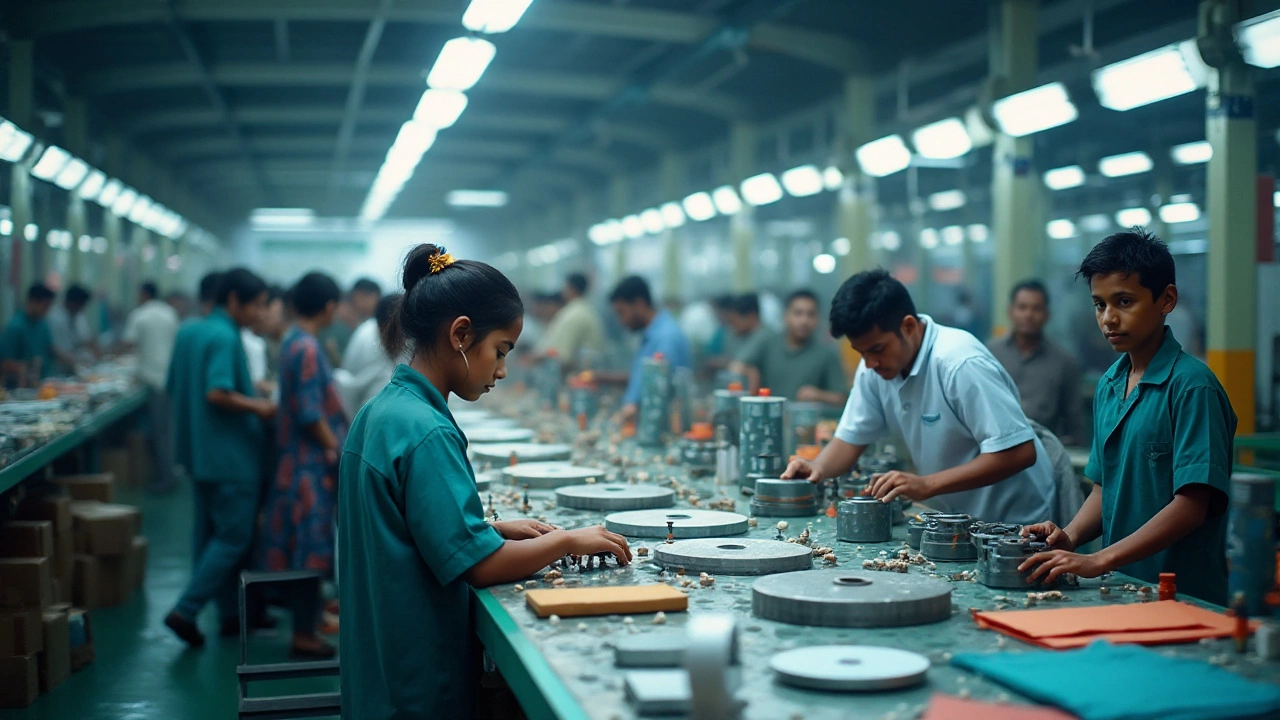
In the sprawling landscape of manufacturing, uncovering which industries are raking in the most money is key to making informed business decisions. For those with a keen entrepreneurial spirit or an interest in scaling their established ventures, knowing where the money flows is crucial.
The fact is, manufacturing is not limited to a single area. From technology to automotive and beyond, various sectors soar in profitability due to different factors like consumer demand and technological innovation. Discovering these lucrative markets can open doors to promising business opportunities.
With this insight, you'll not only learn about the leading industries but also gain practical tips to help you carve a niche in the competitive manufacturing arena.
- Understanding Manufacturing Revenue
- Top Profitable Sectors
- Emerging Market Trends
- Tips for Aspiring Entrepreneurs
Understanding Manufacturing Revenue
Manufacturing revenue, simply put, is the income generated from the production and sale of goods. This revenue can be a significant indicator of a company's health and potential growth within the industry. Across the varying sectors of manufacturing, diverse factors contribute to how revenue is accumulated. These include the cost of production, consumer demand, and global market trends. Understanding these elements can provide businesses with a glimpse into where profits can be maximized. For many companies, the drive to optimize production processes, reduce waste, and embrace innovative technologies like automation are key strategies to increase profitability.
One notable element of manufacturing revenue is its susceptibility to economic fluctuations and consumer preferences. For instance, during economic downturns, luxury items might see a drop in demand, affecting manufacturers' earnings. Conversely, essential goods like healthcare products might see stable or increased demand, independent of economic conditions. The adaptability of a manufacturing company to switch focus or adjust production lines in response to such changes can significantly impact its revenue streams. As a manufacturing business, understanding the external and internal factors affecting revenue can result in more informed strategic decisions.
When we consider profitability in manufacturing, certain sectors often lead the way. As of recent data, industries such as pharmaceuticals, electronics, and automotive consistently show high revenue figures. According to a study by Deloitte, the pharmaceutical industry's global revenue was projected to reach over $1.5 trillion USD by 2023. This is a testament to rising health needs and technological advances driving the production of new medicines. At the same time, the adoption of electric vehicles and smart technology in the automotive and electronics sectors is transforming these industries into revenue-generating powerhouses.
"The future of manufacturing lies in building resilient and diverse supply chains that can withstand global disruptions," states Emma Louise, an industry expert from Manufacturing Today. She emphasizes the role of effective supply chain management in maintaining revenue levels across manufacturing firms. Her insights underline how crucial it is for manufacturers to look beyond internal efficiencies and consider the broader landscape where supply chains play a pivotal role in ensuring steady income streams.
In examining revenue generation within manufacturing, the role of emerging market trends cannot be overstated. Trends such as digital manufacturing, 3D printing, and sustainable practices are increasingly influencing how products are made and sold. The appeal of customization offered by 3D printing, for instance, enables smaller manufacturers to compete with larger firms by providing unique, on-demand products. Meanwhile, sustainable practices not only cater to environmentally conscious consumers but often attract incentives and subsidies, indirectly boosting revenue. Companies that embrace these trends early often find themselves with a competitive advantage, positioning their offerings in a marketplace that values innovation and responsibility.

Top Profitable Sectors
The manufacturing landscape is a bustling arena of opportunities, and knowing which sectors are thriving can significantly impact your business strategy. One of the most lucrative sectors is the technology manufacturing industry. This is hardly surprising, given that we live in a digitally driven world where gadgets and innovations evolve at a rapid pace. From semiconductors to personal electronic devices, the demand is relentless. Companies that manufacture chips and other integral components of phones, computers, and smart technology continue to see soaring profits as they power our daily lives. The growth of the Internet of Things (IoT) further amplifies this demand, opening new pathways for tech manufacturers.
Another bountiful sector is the automotive industry, especially with the rise of electric vehicles (EVs). As consumer interest in sustainable and eco-friendly innovations peaks, car manufacturers are racing to shift gears towards electric and hybrid models. This shift isn't only a nod to environmental concerns but also a robust business move, considering governmental policies worldwide increasingly favor carbon-neutral transportation solutions. With brands jostling for dominance in this new wave of vehicles, the opportunities for manufacturers of batteries and specialized automotive components are immense.
The food and beverage manufacturing industry also takes a significant slice of the profitability pie. With an ever-expanding global population, the need for innovative solutions in food production has never been greater. The sector is rife with opportunities for those who can address the changing dietary preferences and functional food trends. The rise of plant-based foods and water-efficient agriculture propels this industry forward. Manufacturing businesses that can cater to these evolving consumer demands find themselves at the helm of a potentially lucrative journey.
The Apparel and Fast Fashion Industry
The apparel industry, especially fast fashion, continues to be another major player in the profitable sector league. This industry thrives on the swift production of inexpensive garments that replicate high-end fashion trends. While it faces criticism for environmental impact, its profitability remains undeniable. Many new and experienced business ideas in fashion strive for sustainable approaches, integrating recycled materials and ethical manufacturing practices. These strategies answer the dual call for trend-responsive clothing and consumer-conscious consumption.
According to the U.S. Bureau of Economic Analysis, the manufacturing sector contributes nearly $2.3 trillion to the economy, showcasing its vast potential for wealth creation.
In evaluating these sectors, strategic planning and market research are imperative, enabling entrepreneurs to capitalize on the booming segments of industry. Each of these thriving areas represents a critical component of global economic machinery, driven by innovation, consumer needs, and global trends. Such insights can guide budding and seasoned industrialists alike toward flourishing in the competitive world of manufacturing.

Emerging Market Trends
Today's manufacturing landscape is constantly evolving, influenced by technological advancements, globalization, and shifting consumer preferences. One emerging trend is the increasing adoption of automation and artificial intelligence. These technologies streamline production processes, reduce costs, and improve quality control across various sectors such as electronics and automotive. Companies embracing these technological changes not only enhance their efficiency but also gain a competitive edge. For instance, the integration of AI in predictive maintenance has significantly minimized downtime, leading to faster turnaround times for clients.
Another trend reshaping the industry is the growing emphasis on sustainability. With rising environmental concerns, businesses are exploring eco-friendly processes and sustainable materials. This shift is not only crucial for reducing the environmental footprint but also imperative for meeting regulatory standards and consumer demands. Biodegradable packaging, recycled materials, and energy-efficient manufacturing processes are some of the modifications being adopted. As a result, companies that prioritize sustainability not only attract eco-conscious consumers but also benefit from cost savings in the long run.
"Sustainability is no longer about doing less harm, it's about doing more good." - Jochen Zeitz
Customization is another dynamic force revolutionizing how products reach consumers. With advanced manufacturing techniques such as 3D printing, producing bespoke products is more feasible than ever. This trend is particularly evident in industries like fashion and healthcare, where demand for personalized goods rises. By leveraging customization, manufacturers can cater to niche markets and foster a stronger connection with their customer base.
The global supply chain has faced unprecedented challenges due to recent geopolitical tensions and pandemic-related disruptions. As a response, there's a growing trend towards reshoring and localized manufacturing. By moving production closer to the consumer base, businesses can mitigate risks associated with lengthy supply chains and improve lead times. In addition to reducing dependency on international suppliers, reshoring also provides a boost to local economies by creating job opportunities.
As we explore these profitable industries, it becomes evident that staying attuned to emerging trends is crucial. Businesses need to be agile and adaptable, continually seeking innovative solutions that align with market demands. By harnessing these trends, not only can companies enhance their operational efficiency, but they can also tap into new revenue streams that are ripe with potential.

Tips for Aspiring Entrepreneurs
Embarking on a journey in the manufacturing industry can be daunting but equally rewarding if navigated wisely. For those new to the field, the first step is thoroughly understanding the manufacturing landscape. It's vital to research and identify which of the top profitable industries align with your interests and capabilities. With the sector so vast, ranging from tech hardware production to eco-friendly goods, finding your niche is crucial. Once you have an industry in sight, conduct market analysis to pinpoint consumer needs, emerging trends, and potential areas of growth. This foundational knowledge equips you to enter the industry with confidence and foresight.
Another significant tip is to build a robust network. This involves connecting with seasoned professionals who can provide guidance and mentorship. Attending industry conferences, seminars, and trade shows regularly is a practical way to meet potential partners and gain valuable insights into the dynamics of your chosen field. As Sir Richard Branson once said,
"Business opportunities are like buses, there’s always another one coming."Being open to advice and collaboration not only enriches your knowledge pool but also opens doors to unforeseen opportunities and collaborations.
When you are ready to transform your idea into a tangible product, start small but think big. Consider launching a limited product line to gauge consumer reaction and assess market demand. This strategy allows you to refine your offerings based on feedback before scaling up. Key to success in manufacturing is adaptability and responsiveness. Keep an eye on consumer feedback, and don't hesitate to pivot your approach if required. This flexibility not only enhances your product quality but also builds brand loyalty. Remember, successful business ideas evolve through constant iteration.
Finally, leverage technology to your advantage. Incorporating modern, smart technologies into your production process can dramatically improve efficiency and output. This could involve employing automated systems for assembly, using AI for quality checks, or even implementing data analytics to optimize supply chain management. These technological advancements not only cut costs but also ensure your business remains competitive. Stay updated on the latest tech trends and consider how they can be integrated into your operations to push your company ahead in the crowded manufacturing sector.
By following these strategic steps, aspiring entrepreneurs can carve out a successful path in the lucrative world of manufacturing. Remember, the key is to balance innovation with practicality, stay informed, and persistently work towards your goals, no matter how daunting the journey might seem.